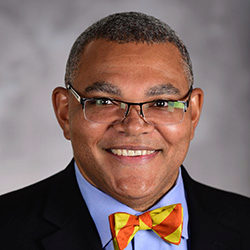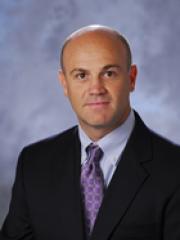 |
| Prof. John-Paul Clarke |
The tremendous career contributions of longtime AE professors John-Paul Clarke and MassimoRuzzene were recognized recently with their appointment to two named professorships.
Clarke was appointed by Dean Gary May to the College of Engineering’s Dean’s Professorship in recognition of his outstanding leadership and many contributions in the areas of air traffic management, aircraft and airline operations. Clarke also holds a courtesy appointment in the H. Milton Stewart School of Industrial and Systems Engineering.
Ruzzene was awarded the first-ever Pratt & Whitney Professorship in Aerospace Engineering, an honor that was officially presented to him by that company’s senior vice president of engineering, Thomas W. Prete during the recently convened Aerospace Engineering School Advisory Council (AESAC) meeting. Ruzzene holds a courtesy appointment within the School of Mechanical Engineering.
For both professors, the financial support that comes with these professorships will provide a well-deserved boost to their current and future research and teaching efforts.
“I am deeply honored to have received this appointment, as it confirms the relevance and importance of my work, and the confidence that Dean May has in my vision for the future,” said Clarke, the director of the Air Transportation Laboratory and an active contributor to GT’s Decision and Control Laboratory. “This is the seed
 |
| Prof. Massimo Ruzzene |
money that will allow me to work on truly innovative concepts, things that will push my research forward.”
Ruzzene echoed those thoughts.
“This will allow me to explore new directions in my research – areas that have not yet been studied or picked up by a sponsor,” he said.
“It will also allow me to invite PhD researchers from other countries to visit Tech, so I can learn from them. I won’t have to wait until they have the funding. I’ll have it. And it will allow me to send my students to other labs, where they can learn things that they can bring back to Georgia Tech. It will be tremendous for their educational experience.”
Clarke is a leading expert in aircraft trajectory prediction and optimization, especially as it pertains to the development of flight procedures that reduce the environmental impact of aviation. His research has been instrumental in changing both the theory and the practice of flight procedure design, and has spurred the global effort to reduce the environmental impact of aviation via changes in operational procedures. He is also an expert in the development and use of stochastic models and optimization algorithms to improve the efficiency and robustness of airline, airport, and air traffic operations.
The director of AE’s Vibration and Wave Propagation Lab, Ruzzene conducts research in metamaterials, structural health monitoring, structural dynamics, and multi-scale modeling of complex structural components. He has authored two books and more than 260 journal and conference publications. He has participated in projects funded by the US Air Force, US Army, US Navy, DARPA, NASA, NSF, and by Boeing, Raytheon and TRW.
Among other things, Clarke said the funds from the Dean’s Professorship will allow him to more deeply explore the concept of trust as it applies to the use of autonomous systems.
“If you replace a human with an autonomous system, you need to trust that that system will work as well if not better than the human. So the question becomes: how do you find a way to quantify the trust have in a human so you can apply it to an autonomous system? I mean, you can’t look into the eyes of a robot and tell if it’s trustworthy, can you?”
Ruzzene said the Pratt and Whitney Professorship will give him greater freedom to expand the focus of his research in wave propagation.
“A lot of work is funded to look at how to prevent waves, to prevent motion in materials,” he said. “There’s a whole other area that looks at ways to transfer information from one place to another using electromagnetic waves. I’m interested in understanding how waves can be used to transport information in small structures. For instance, your cell phone already has a filter that can take an input wave, filter it, and send out a cleaner signal. What if we did different things with that filter?”